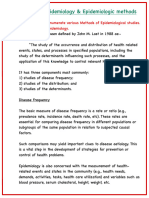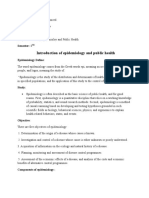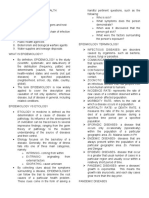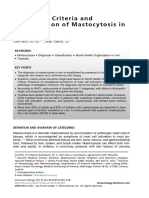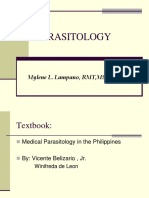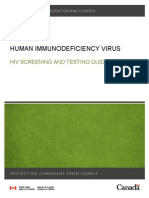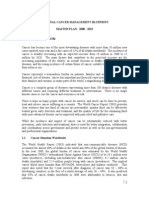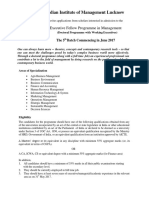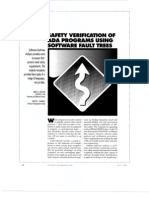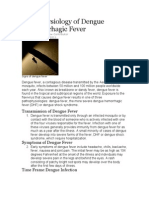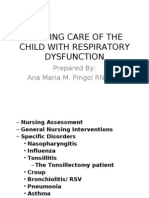Science of Epidemiology-31.8.'16 Modified On 23.10.2016
Science of Epidemiology-31.8.'16 Modified On 23.10.2016
Uploaded by
Alankrit PatnaikCopyright:
Available Formats
Science of Epidemiology-31.8.'16 Modified On 23.10.2016
Science of Epidemiology-31.8.'16 Modified On 23.10.2016
Uploaded by
Alankrit PatnaikOriginal Description:
Original Title
Copyright
Available Formats
Share this document
Did you find this document useful?
Is this content inappropriate?
Copyright:
Available Formats
Science of Epidemiology-31.8.'16 Modified On 23.10.2016
Science of Epidemiology-31.8.'16 Modified On 23.10.2016
Uploaded by
Alankrit PatnaikCopyright:
Available Formats
Basics of Epidemiology
Q. Define the Science of Epidemiology/what is Epid and explain its scope.
Definition of Epidemiology:
Epidemiology is the basic science of preventive and social medicine which covers not only the
study of disease distribution and causation(thereby prevention) but also health and health
related events occurring in human population.
It is the study of the nature, cause, control and determinants of the frequency and distribution of
disease, disability and death in human populations. (Timreck, 1994).
It is the study of the distribution and determinants of disease frequency in human populations.
(McMahon and Trichopoulos, 1996).
The study of distribution and determinants of health-related states or events in specified
populations, and the application of this study to the control of health problems(Last, 1988).
Scope of modern Epidemiology includes:
Identification ofrisk factors of chronic diseases;
Provision of new opportunities for prevention, treatment, planning and improving effectiveness and
efficiency of health services.
Promotion ofhealth and well-beingof the society as a whole and not health of any individuals.
Three components of Epidemiology are:
Disease frequency:refers to study of measurement of frequency of disease& related health events
frequency of occurrence of adisease, disability and death in the form of rates and ratios, viz: prevalence
rate, incidence rate, death rate etc, which are the basic measures of disease frequency.
o These rates/ measures are essential for comparing the disease frequency in different population or subgroup of the same population leading to suspected causes/ factors of the disease occurrence in a given
population.
o This helps in development of strategiesfor prevention and control of health problems.
health related events, like, health needs, health care utilisation etc. are included besides the disease
measurement in a given population over a period of time.
Variables like, BP,height etc.
Distribution of disease: refers to study of distribution patterns in terms of person, place and time;
increase or decrease of disease over a span of time in a community;
variations in patterns of disease suggesting control or prevention of disease.
Determinants of disease: refers to study of Underlying causes/risk factors causing disease.
This aspect helps to develop analytical strategies, such as analytical epid.
Aims of Epidemiology:
The broadaims ofEpidemiology are to:
Describe the distribution and magnitudeof health & disease problems in human population.
Identify causes/risk factors in pathogenesis of disease:
Provide data essential for :
o Planning,Implementation and Evaluation of services for prevention, control &treatment of disease
o Setting up of priorities among those services.
Eliminate/reduce health problems and their consequences.
Promote health and well-being of society as a whole.
Epidemiological Approach/ Principles of Epidemiology:
The epidemiological approach is based on:
Asking questionsrelated to health events:
o What is the problem
o What is the magnitude
o Where did it happen
o Who are affected
o Why did it happen
Asking questions related to health action:
o What can be done to reduce the problem
o How can it be prevented in future
o What are the resources required etc.
Making comparisons:
o Comparisons can be made of two or different groups having a particular disease with those not
having the same disease.
Basic Measurements in Epidemiology focus on:
measurement of mortality and morbidity in human population
measurement of disability and natality
measurement of presence, absence and distribution of disease
measurement of health facilities available
measurement of utilisation of health services etc.
The basic requirements of measurements are :
- validity
:
- reliability :
- accuracy
:
- sensitivity :
- specificity :
The purpose of quality control in measurement is to reduce errors as much as possible.
However, measurement of psycho-social aspects have not been covered.
Tools of Measurement:
Three basic tools of measurement in Epidemiology are Rates, Ratios and Proportions.
Rate measures the occurrence of death/development of disease in a population during a given
time period. Rate comprises of numerator, denominator, time specification and multiplier. Rate is
always expressed as per 1000 or per 10,000 or per 1 lakh.
Example: death rate = no. of deaths per year
-------------------------- * 1000
mid-year population
Categories of rate are:
- crude rate : are the actual observed rates such as birth and death rates (unstandard)
- specific rate : these are actual observed rates due to specific causes. eg. TB occurring in
specific groups or sex annually or monthly, etc.
- standardised rate: obtained by direct or indirect method of standardisation. eg age and sex
standardised rates.
Ratio is the measurement of disease frequency which expresses relation in size between two
random quantities. It is the result of dividing one quantity by another and is expressed as x:y or
x/y.
2
eg.(i) ratio of white blood cells in relation to red blood cells is expressed as 1:600 or 1/600. This
means that for each white blood cell there are 600 red blood cells.
(ii) Other examples include- sex-ratio, bed-patient ratio, doctor-population ratio etc.
Proportion is a ratio which indicates the relation in magnitude of a part of the whole. It is
expressed as percentage.
Example:
no. of children with scabies at a particular time
---------------------------------------------------------total no. of children in the village at the sametime.
* 100
Classification of Epidemiological Studies/ Epidemiologic Methods:
Epidemiological studies can be classified as Observational Studies and Experimental studies.
Observational studies:investigator does not intervene; but only observes the extent of exposure of a person to a
disease or the causative factors related to occurrence of the disease.
(a) Descriptive studies: relate to description of the occurrence of disease in a population.
(b) Analytical studies: relate to analysing relationship of health status and other variables.
(i)
(ii)
(iii)
(iv)
Ecological:co-relational- with population as unit of study
Cross-sectional: prevalence -with individuals as unit of study
Case-control :case reference- with individuals as unit of study
Cohort:follow upwith individuals as unit of study
Experimental/interventional studies:involve effort to change progress of disease/determinant of a disease.
(a) Randomised controlled studies: clinical trials- with patientsas unit of study
(b) Field Trialswith healthy peopleas unit of study
(c) Community Trials: Community intervention studies-with communities as unit of study
USES OF EPIDEMIOLOGY:
i.
ii.
iii.
iv.
Elucidates disease etiology:Identifiescausation of diseases related to genetic causes or environmental factors.
Provides description of health status of population: Helps to explain local disease patterns and formulate
preventive measures suitable to a particular community, especially with a particular disease outbreak .
Helps to describe natural history of disease by identifying factors related to(i) course of the disease, (ii)duration
of the disease and(iii) probability of outcome by age, sex, etc.
Helps to provide guidance in administration and evaluation of health services: the knowledge of frequency and
natural history of diseases in the population helps in the estimation of number of hospital beds etc. required for patients with
specific diseases.
v.
vi.
vii.
viii.
ix.
x.
Provides guidance to policy makers for planning intervention programmes: through knowledge of how many
cases of a particular disease are prevalent in a given population during a given period of time.
Helps in conductingepidemiological studies for Prevention of disease and Promotion of health.
Descriptive studies in epidemiology provides:
Data regarding magnitude and types of diseases in a community (morbidity/ mortality rates).
Clues to causation of diseases.
Backgrounddata for planning, organising, preventive and curative services.
Contribution to research in disease occurrence and its prevention.
Analytical Epidemiological studies provide information on:
Frequency of exposure to a disease
Estimation of disease risk associated with exposure to disease.
Experimental Studies in Epidemiology are useful for:
Investigation of disease aetiology(causes) and preventive& therapeutic measures/appropriate interventions.
Evaluation of Interventions for:(i)health promotion(ii) preventive measures (iii) public health services provided.
----------------------------
Types of Epidemiological Studies: (DETAILS)
I.DescriptiveEpidemiological Studies:
Study of frequency of health events by asking questions like:
Who is getting the disease? (person distribution )
Where is it occurring
(place distribution) and
When is the disease occurring (time distribution).
Steps/ Procedures in Descriptive studies:
Defining the population to be studied and not individuals-criteria forpopulation base:
Total no. of people to be studied;
Composition: age, sex, occupation, cultural characters.
Whole population in a geographic area/ representative sample;
Selected population group needs to be chosen: age group, occupational group,Sex group,
hospital patients,school children etc.
Population needs to beLarge(for generalisations to be made).
Stable population(without being in or out migration population);
Community participation should be visible;
Health facility should be located nearby.
Defining the disease/ condition being investigated under study:
Precise and accurate estimate(measurement) of disease in a given population is required on
who has the disease and who does not to have the disease.
Describing the Disease:The occurrence and distribution of disease by time, place and person:
(i)Time distribution: whereby, Pattern of disease may be described by:
- time of occurrence- week, month, hour of onset of disease, day of week etc.
- whether seasonal occurrence;
- whether there is periodic increase or decrease;
- consistency of time trend, which are generally of 3 kinds:
o Short term fluctuations/trends: are occurrences of diseases which may appear in the form of
epidemics, which are generally of 3 types:
Common source epidemics- which may be single or continuous exposure:
- Common source with singleepidemic:
- these are known as point source epidemics and exposure to disease agent is brief;
- the epidemic curve rises and falls rapidly;
- clustering of cases occur resulting in development of all within one incubation
period.
- these epidemics may due to exposure to infectious agent, contamination of
environment,(air, water, soil) by industrial pollutants etc.
- Common source with Continuous/ repeated exposure:
-Repeated / prolonged exposure of disease takes place with same / multiplesources.
e.g. a well of contaminated water may infect people for a prolonged period with
repeated exposures to the contaminated water resulting in disease outbreaks.
Propagated epidemics- which may be transmitted fromperson to person, anthropod
vector or animal reservoir.
4
This epidemic is of infectious origin resulting from person-person transmissioneg:spread of hepatitis and polio.
the epidemic curve rises gradually and falls over a much longer period of time.
Spread of infection depends upon period of exposure to the infected persons.
o Periodic trends/ fluctuations: may be of seasonal trend or cyclic trend.
- Seasonal trend-disease occurrence due to variation in environmental conditions;
e.g:(i) measles occur in early spring; upper respiratory infections occur in winters while,
bacterial infections are prominent in summer months
(ii)Seasonal variation/trend of Dengue can be seen in Table given below:
Table-Seasonal Variation- Dengue
Months
January
Februar
y
March
April
May
June
July
Nov
Dec
2005
151
80
2006
281
193
2007
83
64
50
68
130
172
742
1500
800
181
175
185
279
478
1900
910
46
50
175
186
487
802
201
From the above Table, it is clear that each year, rise of dengue is from May- Nov. However,
there is decrease in the occurrence of the disease in winter month of Dec.
Cyclic trend- Some diseases occurin cyclic periods; eg: influenza is seen to occur after
every 7-10 years; accidents in US is witnessed more during weekends etc.
o Long term trends/secular trends: when changes in occurrence of disease happens over a
long period of time.eg: lifestyle diseases like diabetes, lung cancer, heart diseases have
shown upward trend in developed countries while there is decline in Tuberculosis, typhoid
etc. in these countries.
(ii)Place distribution:
i.
ii.
iii.
-
-This is distribution of disease in different population not only between different countries but
also within countries (geographic variation in disease occurrence).
- These variations in mortality and morbidity are classified as international variations, national
variations, rural-urban variation and local distributions:
Eg. cancer of stomach is common in Japan but unusual in US. Cancer of oral cavity and
uterine cervix are common in India, etc.These variations lead to study of cause-effect
relationships between environmental factors and disease for prevention of disease.
e.gDistribution of malaria, leprosy, nutritional deficiency diseases vary within different parts
of India. Such information helps to demarcate the affected areas for providing appropriate
health care services.
e.gThe variations in death rates (infant and maternal mortality rates) are higher in rural than
urban areas in India, which may be due to differences in social class, lack of medical care,
sanitation, education, etc.
All diseases showdefinite patterns of geographic distribution which may provide evidence of
source of disease and mode of spread.
By relating these variations to agent, host and environmental factors, the cause of the disease
and its frequency can be found out.
Diseases are also classified by geographic occurrence as:
Endemic: habitual presence of a disease in a given geographical area.
Epidemic: occurrence of group of diseases in a community in excess of normal expectancy or an
outbreak.
o Pandemic: world-wide epidemic is known as pandemic.
o
o
(iii)
Person distribution:
5
The disease is characterised by defining the persons who develop the disease by age, sex,
occupation, marital status, social class (host factors in epidemiological studies), etc.
- Some of the host factors are :
i.
age: certain diseases are more frequent in certain age groups than in others. Eg.
measles in childhood and arthritis in old age however, communicable disease is
common to all age groups.
ii.
Sex: certain chronic disease such as diabetes etc. are common in women than men
while lung cancer and heart diseases are less frequent in women.
iii.
Marital status: some studies indicate that mortality rates were lower in married males
and females than the unmarried ones of the same age and sex. (K.Park)
iv.
Occupation: while workers in coal mines suffer from silicosis, those in sedentary jobs
suffer from heart diseases.
v.
Social class: certain diseases like hypertension, diabetes, etc. are common in upper
classes than in lower class.
Measurement of Disease:
The information on disease load in a population is available in terms of mortality, morbidity,
disability, etc. the magnitude of health and disease problems in human population is obtained
bycross-sectional studies and longitudinal studies in descriptive epidemiology.
Cross-sectional studies: (i)arethe simplest form of observational study based on a
single examination of a cross-section of population at one point of time.
(ii)These studies are also known as prevalent study.
(iii)Cross-sectional are more useful for chronic diseases like hypertension.
(iv)Cross-sectional study provides information about disease prevalence but very less
information about natural history of disease etc.
Longitudinal studies: observations are repeated in the same population over a
prolonged period of time through follow-up. Longitudinal studies are useful to study:
(i)natural history of disease,(ii) identification of risk factors of disease and(iii) finding
out incidence rate.
Comparing with known indices:
The causes of diseases can be understood by making comparisons between different
populations or sub-groups of the same populations.
Formulation of hypothesis :
By studying the distribution of disease and by utilizing techniques of descriptive
epidemiology, it is possible to formulate hypothesis relating to causation of disease.
Uses of Descriptive Epidemiology:
Descriptive studies provide:
- Data regarding magnitude and types of diseases in a community (morbidity and
mortality rates).
- Clues to causation of diseases.
- Background data for planning, organising, preventive and curative services.
- Contribution to research in disease occurrence.
II. Analytical Epidemiology:
- Study ofdeterminants: search for causes/risk factors;
- Response to a study hypothesisby using various epid methods.
- In contrast to descriptive study which looks at entire population, the analytical study looks
at the individual within the population.
6
- the objective of analytical study is to test hypothesis unlike formulation of hypothesis in
descriptive studies.
- Analytical studies comprise of 2 types of observational studies:
i.
Case control study (comparison studies between cases and control groups)
ii.
Cohort study (study of group of people who share common characteristic or
experience within a defined time period).
i.
o Experimental/Intervention (Applied Epidemiology):
- All health outcomes through application of epid. Methods.
- These studies are similar to cohort studies carried out under direct control of the
investigator.
- The aim of experimental studies are to provide :
scientific proof of causes or risk factors in control diseases.
ii.
Method of measuring effectiveness and efficiency of health services for
prevention, control and treatment of diseases.
You might also like
- Palliative Care Billing 101Document47 pagesPalliative Care Billing 101mturchiano100% (1)
- Introduction To General Pathology II 2013Document21 pagesIntroduction To General Pathology II 2013talal_11No ratings yet
- Sanjay Sharma's Notes For MRCPDocument7 pagesSanjay Sharma's Notes For MRCPMoe Zaw Lin100% (2)
- Principles of Epidemiology & Epidemiologic MethodsDocument62 pagesPrinciples of Epidemiology & Epidemiologic MethodsMonish NavaneethanNo ratings yet
- Unit - 4 Environmental and Occupational EpidemiologyDocument47 pagesUnit - 4 Environmental and Occupational Epidemiologyravdeep146chahalNo ratings yet
- Public Health Implications of Wireless TechnologiesDocument14 pagesPublic Health Implications of Wireless TechnologiesNikolaos Kalantzis100% (1)
- Chapter Four HealingDocument70 pagesChapter Four HealingAhmed Azeez100% (1)
- 2011 - Metformin - Multi-Faceted Protection Against CancerDocument22 pages2011 - Metformin - Multi-Faceted Protection Against CancerVladDaculNo ratings yet
- Tumor Marker GUPERDocument15 pagesTumor Marker GUPERyessiNo ratings yet
- Introduction of Epidemiology and Public Health - (Roll No.02)Document6 pagesIntroduction of Epidemiology and Public Health - (Roll No.02)HeroNo ratings yet
- BJU International - 2020 - Devlin - Benign Prostatic Hyperplasia What Do We KnowDocument11 pagesBJU International - 2020 - Devlin - Benign Prostatic Hyperplasia What Do We Know50 Kamila AmatullahNo ratings yet
- Oral Fecal Route Diseases Oral Fecal Route Diseases: Afroz Lakhani RN, BSCNDocument74 pagesOral Fecal Route Diseases Oral Fecal Route Diseases: Afroz Lakhani RN, BSCNafrozlakhaniNo ratings yet
- Infectious Diseases: Robin Cochran-Dirksen (Many Slides From Bioedonline Baylor Christine Herrmann PHD)Document21 pagesInfectious Diseases: Robin Cochran-Dirksen (Many Slides From Bioedonline Baylor Christine Herrmann PHD)Aziah HusainNo ratings yet
- Epidemiology and Public HealthDocument2 pagesEpidemiology and Public HealthLady DanielleNo ratings yet
- Cause of Death - 98Document18 pagesCause of Death - 98Suhrud Panchawagh100% (1)
- Immunity To Viruses Blok 22 2011Document11 pagesImmunity To Viruses Blok 22 2011Nisha AnggiaNo ratings yet
- Immunity To FungiDocument29 pagesImmunity To FungiNoor NawawraNo ratings yet
- Cellular and Molecular Immunology Module1: IntroductionDocument32 pagesCellular and Molecular Immunology Module1: IntroductionAygul RamankulovaNo ratings yet
- Akin 2014Document12 pagesAkin 2014vaneebusatoNo ratings yet
- Parasitology 2019 StudentDocument165 pagesParasitology 2019 StudentCharlene SuliganNo ratings yet
- Superficial Fungal Infections (2019)Document6 pagesSuperficial Fungal Infections (2019)mustika rachmaNo ratings yet
- Group 4: Global Recommendation On Physical ActivityDocument50 pagesGroup 4: Global Recommendation On Physical ActivityMYLE MANAYONNo ratings yet
- Assignment On Forensic ScienceDocument11 pagesAssignment On Forensic ScienceRakib Hossain100% (1)
- 2021 Histopathology Curriculum - PDF 87181374Document67 pages2021 Histopathology Curriculum - PDF 87181374Camelia-Elena PlesaNo ratings yet
- Parasitology GuidelineDocument40 pagesParasitology GuidelineMompati LetsweletseNo ratings yet
- Immunology Lecture NotesDocument20 pagesImmunology Lecture NotesEmmanuel ogenyiNo ratings yet
- En HIV Screening Guide 2013Document57 pagesEn HIV Screening Guide 2013radersNo ratings yet
- NeutrophiliaDocument15 pagesNeutrophiliaJami, Madhu MihiraNo ratings yet
- West Nile VirusDocument10 pagesWest Nile VirusKevin C. AguilarNo ratings yet
- Phylum Platyhelminthes (Flatworms) : Important InformationDocument26 pagesPhylum Platyhelminthes (Flatworms) : Important InformationYoussef EmadNo ratings yet
- Medical Parasitology: "TheDocument35 pagesMedical Parasitology: "Therodelagapito100% (2)
- Cancer Management Blueprint FINAL 27 MARCH 2008Document165 pagesCancer Management Blueprint FINAL 27 MARCH 2008Gan Tzyh KeongNo ratings yet
- BIOSYNTHESIS OF COPPER NANOPARTICLES USING OCIMUM SANCTUM LEAF EXTRACT AND ITS ANTIMICROBIAL PROPERTYAnuj PaperDocument5 pagesBIOSYNTHESIS OF COPPER NANOPARTICLES USING OCIMUM SANCTUM LEAF EXTRACT AND ITS ANTIMICROBIAL PROPERTYAnuj PaperrkalsiNo ratings yet
- A Brief History of Muslim Scientists Contribution To The WorldDocument23 pagesA Brief History of Muslim Scientists Contribution To The WorldSanwal GillNo ratings yet
- Parasitology:: Classification of ParasitesDocument17 pagesParasitology:: Classification of ParasitesIrfan Pathan KakarNo ratings yet
- Tumor Immunology: Zhongshan School of Medicine, SYSUDocument84 pagesTumor Immunology: Zhongshan School of Medicine, SYSUleyrea100% (1)
- LO 1 Classification of AnemiaDocument3 pagesLO 1 Classification of Anemiamuthia saniNo ratings yet
- Vaccines PART 1Document57 pagesVaccines PART 1shahbaz100% (1)
- Lecture Notes - Human PathologyDocument623 pagesLecture Notes - Human PathologyOtema James100% (1)
- Non Hodgkin LymphomaDocument53 pagesNon Hodgkin LymphomaMeilina Elin WardhaniNo ratings yet
- Tuberculosis: Cause and TransmissionDocument6 pagesTuberculosis: Cause and TransmissionAnkit SharmaNo ratings yet
- The Immune System and Lymphoid OrgansDocument68 pagesThe Immune System and Lymphoid OrgansAbraham Dawson machachaNo ratings yet
- Basic Immunology IDocument57 pagesBasic Immunology Idevika priyavathi0% (1)
- ParasitologyDocument37 pagesParasitologyyomifNo ratings yet
- History of Microbiology and Contributors in MicrobiologyDocument22 pagesHistory of Microbiology and Contributors in MicrobiologyGounder KirthikaNo ratings yet
- Immune System: From Wikipedia, The Free EncyclopediaDocument75 pagesImmune System: From Wikipedia, The Free EncyclopediaDewi PratiwiNo ratings yet
- Microbiology BiostatisticsDocument89 pagesMicrobiology BiostatisticsNiyati Karetha100% (2)
- Microbial Spoilage B Pharma 305 TDocument28 pagesMicrobial Spoilage B Pharma 305 TAbrar AnsariNo ratings yet
- Dengue Guidelines WHO 2011Document78 pagesDengue Guidelines WHO 2011Yhoga Timur LagaNo ratings yet
- Cancer Immune TherapyDocument452 pagesCancer Immune TherapyatyNo ratings yet
- Vena Cava Superior SyndromeDocument12 pagesVena Cava Superior SyndromeAgnes SetiawanNo ratings yet
- Foodborne Intoxication and ToxicoinfectionsDocument73 pagesFoodborne Intoxication and ToxicoinfectionsAyuIrhoniRosadiNo ratings yet
- Biostatistics and Epidemiology2011 PDFDocument5 pagesBiostatistics and Epidemiology2011 PDFMayom Mabuong100% (1)
- Chemical Mediators of InflammationDocument2 pagesChemical Mediators of InflammationMythily VedhagiriNo ratings yet
- Autoimmune Disease - : Immune DeficienciesDocument34 pagesAutoimmune Disease - : Immune Deficienciesahana roy100% (1)
- Pathology 2 PDFDocument18 pagesPathology 2 PDFfadoNo ratings yet
- Antigens and AntibodiesDocument8 pagesAntigens and AntibodiesLianneRao100% (1)
- Infection in CancerDocument34 pagesInfection in CancerSheikNo ratings yet
- Analytical EpidemiologyDocument7 pagesAnalytical EpidemiologySamridhi SrivastavaNo ratings yet
- 3.balantidium ColiDocument20 pages3.balantidium ColiBoateng DerrickNo ratings yet
- Measures of Disease Frequency NOTESDocument22 pagesMeasures of Disease Frequency NOTESSJ Jung100% (1)
- Hereditary Spherocytosis, A Simple Guide To The Condition, Diagnosis, Treatment And Related ConditionsFrom EverandHereditary Spherocytosis, A Simple Guide To The Condition, Diagnosis, Treatment And Related ConditionsNo ratings yet
- Efpm Announcement RevisedDocument4 pagesEfpm Announcement RevisedAlankrit PatnaikNo ratings yet
- Entity Framework Cheat Sheet 1: SchoolcontextDocument3 pagesEntity Framework Cheat Sheet 1: SchoolcontextCosma AurelianNo ratings yet
- The Model-View-Controller (MVC) Pattern With C# - WinForms - CodeProjectDocument12 pagesThe Model-View-Controller (MVC) Pattern With C# - WinForms - CodeProjectAlankrit PatnaikNo ratings yet
- Ada Programs: UsingDocument12 pagesAda Programs: UsingAlankrit PatnaikNo ratings yet
- Problem 1: Find I and VDocument4 pagesProblem 1: Find I and VAlankrit PatnaikNo ratings yet
- Traffic BpitDocument3 pagesTraffic BpitAlankrit PatnaikNo ratings yet
- Sensor 75015728Document16 pagesSensor 75015728SisEleN Neuquen ArgentinaNo ratings yet
- Sixth Sense Tutoring SystemDocument27 pagesSixth Sense Tutoring SystemAlankrit PatnaikNo ratings yet
- Shadi A.K Shirazi Jamie Westell Arash JamalianDocument47 pagesShadi A.K Shirazi Jamie Westell Arash JamalianAlankrit PatnaikNo ratings yet
- Case of InfertilityDocument4 pagesCase of InfertilityVirag PatilNo ratings yet
- Poisoning - DR MD Monjurul AhsanDocument23 pagesPoisoning - DR MD Monjurul Ahsanbingbingbing000888No ratings yet
- Cefixime and DicloxacillinDocument3 pagesCefixime and DicloxacillinCurtis CrawfordNo ratings yet
- Nursing Care Plan Date and Shift Assessment Need Nursing Diagnosis Goal of Care Nursing Interventions Evalu AtionDocument5 pagesNursing Care Plan Date and Shift Assessment Need Nursing Diagnosis Goal of Care Nursing Interventions Evalu Ationqriztin18No ratings yet
- Arthritis PDFDocument4 pagesArthritis PDFArchana MoreyNo ratings yet
- IV Complications Ward ClassDocument28 pagesIV Complications Ward ClassMel Belisario TubeoNo ratings yet
- Canberra Hospital: Post Operative Handover and Observations - Adult Patients (First 24 Hours)Document7 pagesCanberra Hospital: Post Operative Handover and Observations - Adult Patients (First 24 Hours)Zandile Angeline DhlomonseleNo ratings yet
- Ojrmi Raft1009 PDFDocument9 pagesOjrmi Raft1009 PDFElli PapadakiNo ratings yet
- Pathophysiology: Bipolar DisorderDocument3 pagesPathophysiology: Bipolar DisorderPae EdejerNo ratings yet
- MCI FMGE Previous Year Solved Question Paper 2007Document0 pagesMCI FMGE Previous Year Solved Question Paper 2007Sharat ChandraNo ratings yet
- Parotid 121206120631 Phpapp01Document26 pagesParotid 121206120631 Phpapp01shravani100% (1)
- Leep Pnea: Reporters: Desdechado, Niellan Ferrer, Jessa Magkilat, Hanzarri Palmes, Kamillah Sabat, ChristianDocument27 pagesLeep Pnea: Reporters: Desdechado, Niellan Ferrer, Jessa Magkilat, Hanzarri Palmes, Kamillah Sabat, ChristianEira LopezNo ratings yet
- Emotional Adjustment & Emotions in Health and IlnessDocument12 pagesEmotional Adjustment & Emotions in Health and IlnessBijia KhumanNo ratings yet
- NCP Preeclampsia and EclampsiaDocument16 pagesNCP Preeclampsia and EclampsiaBiway Regala100% (1)
- Chodon Purer Rajar Magi Khawar Hishab Kore FellamDocument3 pagesChodon Purer Rajar Magi Khawar Hishab Kore Fellamgoru chorNo ratings yet
- SiadhDocument16 pagesSiadhGokul Rajan100% (1)
- Severe Cholestasis and Renal Failure Associated With The Use of The Designer Steroid Superdrol™ (Methasteron™) A Case Report and Literature ReviewDocument3 pagesSevere Cholestasis and Renal Failure Associated With The Use of The Designer Steroid Superdrol™ (Methasteron™) A Case Report and Literature ReviewPádraig Ó ĊonġaileNo ratings yet
- Grasso 2018Document5 pagesGrasso 2018Nia DefinisiNo ratings yet
- Oral Pemphigus Vulgaris: A Case Report With Direct Immunofluorescence StudyDocument4 pagesOral Pemphigus Vulgaris: A Case Report With Direct Immunofluorescence StudyYeni PuspitasariNo ratings yet
- Rizqi Anang Anandito - P1337430118023 - Tugas Epidemiologi TM 8Document7 pagesRizqi Anang Anandito - P1337430118023 - Tugas Epidemiologi TM 8Par zivalNo ratings yet
- Understanding and Recognizing Binge Eating Disorder Brochure For NPM 569Document2 pagesUnderstanding and Recognizing Binge Eating Disorder Brochure For NPM 569Ruqayyah Rivera ColinNo ratings yet
- Pathophysiology of Dengue Hemorrhagic FeverDocument4 pagesPathophysiology of Dengue Hemorrhagic Feverava_luna_1No ratings yet
- Call If... : How To Help Someone Having A SeizureDocument1 pageCall If... : How To Help Someone Having A SeizureZin KoNo ratings yet
- Nursing Care Plan For Down SyndromeDocument20 pagesNursing Care Plan For Down SyndromeMuhammad Jefri LukmanNo ratings yet
- Toxins 13 00159Document14 pagesToxins 13 00159Daniela RodriguesNo ratings yet
- Intensive Care Management of The Head Injured Patient: Review ArticleDocument14 pagesIntensive Care Management of The Head Injured Patient: Review ArticlerickyGKNo ratings yet
- Text Reading NewsDocument7 pagesText Reading Newsayu lestariNo ratings yet
- Nursing Care of The Child With Respiratory DysfunctionDocument54 pagesNursing Care of The Child With Respiratory DysfunctionAlexis Coronado100% (1)



